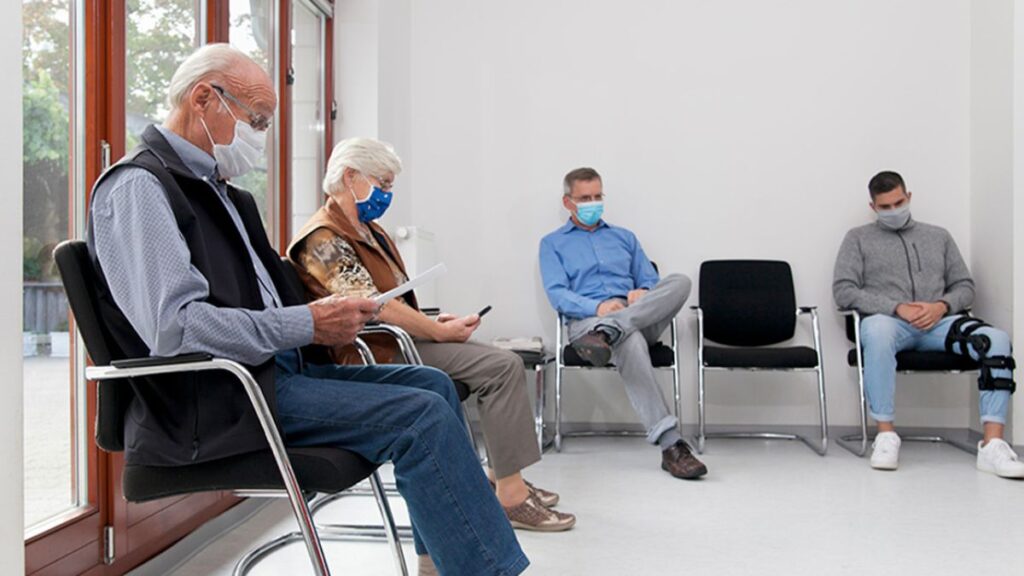Long wait times have long plagued healthcare facilities, affecting patient satisfaction and efficiency. Crowded waiting areas can cause frustration and anxiety, eroding confidence in the care provided. Rising demand from population growth and complex needs makes traditional processes unsustainable. Reducing congestion is now crucial for ensuring safety and effective infection control. Healthcare providers are adopting innovative, patient-centered technologies, such as check-in kiosks, mobile apps, and automated notifications, to streamline visits, reduce paperwork, and enhance patient experiences. Digital solutions from pre-appointment to post-care eliminate many waiting room obstacles. They empower patients with real-time info, decreasing anxiety and improving trust, while cutting check-in lines, cancellations, and infection risks. Transitioning from paper forms to digital check-ins and AI analytics enables quicker access to care, improved communication, and data-driven decision-making. These tools allow clinics to adjust staffing and space dynamically, improving operations and reducing overcrowding. They also promote equitable, private care that is accessible regardless of age, language, or technical skills. Scalable from small clinics to large hospitals, these technologies demonstrate a commitment to efficient, fair, and compassionate healthcare.
Digital Check-In Systems
Digital check-in systems have revolutionized the initial point of contact between patients and healthcare providers. Instead of waiting in line and filling out paper sign-in forms that clutter reception desks, patients can now register using mobile devices or self-service kiosks upon arrival. Some systems even enable pre-registration at home, allowing patients to provide demographic information, upload their ID and insurance cards, and complete preliminary health questionnaires before visiting the facility. The result is a smoother, faster intake process that eliminates most administrative bottlenecks and quickly sends patients directly where they need to be.
For example, a comprehensive healthcare network in the Northeastern U.S. implemented digital check-in kiosks across dozens of locations, observing significant reductions in average wait times and far less chaos at the front desk. Staff are then free to devote more attention to patients with complex needs, improving both service and morale. This shift also supports infection prevention efforts, as patients spend less time in shared spaces and handle fewer physical items, such as pens, thereby decreasing the chance of spreading illness. Many urgent care clinics now rely on digital check-in as a foundational tool for efficient, safe, and hygienic environments. To learn more about these positive impacts in real clinical settings, see https://kiosk.com/market-solutions/healthcare-kiosks/patient-check-in-kiosks/.
Virtual Queue Management
Virtual queue management provides a more efficient approach to patient flow, allowing patients to check in and join queues remotely—sometimes even days in advance of their actual visit. Using mobile apps or SMS-based systems, patients are given live updates on their expected wait times and can move freely until they need to be physically present. This means that instead of crowding into small waiting rooms or hallways, patients can relax in alternative spaces, such as their cars, nearby outdoor areas, or even at home, until it’s almost their turn. This flexibility is a game changer for minimizing stress, preventing unnecessary close contact, and supporting families with young children, who can become anxious in confined waiting areas.
Research consistently highlights the significant benefits in patient satisfaction associated with these systems. Patients appreciate being kept informed with proactive updates, and providers report fewer traffic jams during peak periods. Safety is also improved: by reducing the density of people in shared environments, the risk of viral transmission drops.
Centralized Appointment Scheduling
Centralized appointment scheduling consolidates all bookings, cancellations, and rescheduling activities into a single, secure digital platform. For staff, this means less juggling of paper calendars, phone logs, or siloed systems, enabling a birds-eye view of provider and room availability. For patients, it offers a familiar and easy-to-navigate online experience, often accompanied by automated reminders and quick options for rescheduling or adding information prior to their appointment.
The transparency of centralized systems reduces the likelihood of double bookings or communication breakdowns, allowing clinics to optimize scheduling resources more effectively. It also increases adherence to best practices in appointment management by integrating automated reminders and targeted digital check-in links—both of which can significantly reduce arrival times, confusion at the front desk, and, in turn, waiting room congestion. Many modern platforms can even pair high-need patients with the specialized clinicians most qualified to help, further improving satisfaction and reducing unnecessary re-visits.
Digital Wayfinding Solutions
Navigating a large clinic or sprawling hospital campus can be overwhelming, especially during stressful times. Digital wayfinding tools are designed to demystify this journey, helping new and returning visitors alike quickly locate entrances, offices, or departments with minimal stress and confusion. Interactive signage, digital directories, and smartphone-based navigation apps can provide turn-by-turn directions, voice guidance for the visually impaired, and real-time alerts if a patient’s destination changes at the last minute.
Studies show that nearly 80% of patients report higher confidence and satisfaction when reliable wayfinding aids are available. These digital solutions not only reduce congestion in central lobbies and corridors by preventing lost patients from wandering or clogging help desks, but also boost overall punctuality for scheduled visits.
Interactive Patient Engagement Tools
Improving the waiting experience requires more than just moving people more efficiently—it’s about addressing patient anxiety and uncertainty during downtime. Interactive patient engagement tools do just that, leveraging digital screens, tablets, or kiosks to share timely information and keep patients occupied while they wait. These platforms might display real-time wait updates, health education videos, or even relaxation exercises specifically designed to alleviate stress.
Many facilities report that such features can help distract patients from the inconvenience of waiting, making the time pass more quickly. When patients are better informed and less anxious, their perception of care quality rises dramatically. Some hospitals have even utilized engagement tools to gather patient feedback or deliver personalized messages, thereby helping to build connections and enhance future care. Higher satisfaction scores and positive online reviews often follow these technology investments.
AI-Driven Predictive Modeling
Artificial Intelligence (AI) is revolutionizing the management of waiting room congestion by allowing facilities to forecast patient arrivals, peak surge times, and bottlenecks with remarkable accuracy. AI-powered predictive tools can analyze years of appointment history, demographic patterns, and seasonal effects to generate recommendations for optimal staffing, cleaning, and resource allocation. Hospitals and clinics that adopt AI have reported a more even patient flow, reduced overbooking, and greater resilience to unexpected spikes or drops in appointment attendance.
Emergency departments, in particular, benefit from AI-driven insights, which enable rapid responses to overcrowding and help ensure that patients with urgent needs are prioritized appropriately.
Privacy-Preserving Crowd Density Estimation
Some of the latest advances in managing waiting room congestion focus not only on efficiency, but also on patient privacy. Privacy-preserving crowd density estimation tools are helping healthcare facilities monitor and predict occupancy in shared spaces without resorting to invasive cameras or identifying technologies. These systems may employ non-intrusive methods, such as ambient sound analysis, Wi-Fi signal mapping, or infrared sensors, to estimate real-time crowd levels.
When staff receive accurate crowd density insights, they can adjust workflow, redirect foot traffic, or open supplementary spaces as needed, keeping waiting rooms comfortable and preventing overcrowding. Patients’ anonymity is preserved, ensuring that these operational improvements don’t come at the expense of personal privacy—an essential trust factor in healthcare. As more organizations adopt such privacy-sensitive innovations, they can improve both the functionality and the reputation of their facilities.
Conclusion
Patient-focused technology is fundamentally reshaping healthcare waiting room by offering measurable improvements in patient satisfaction, safety, and workflow efficiency. Modern digital solutions—including check-in systems, virtual queues, AI-driven analytics, and privacy-protecting crowd management tools—empower both patients and providers, ultimately delivering more responsive, compassionate, and efficient care. As new pressures and opportunities arise, ongoing investment in these smart technologies will be crucial for healthcare organizations seeking to deliver positive experiences and keep pace with the evolving needs of their communities.






